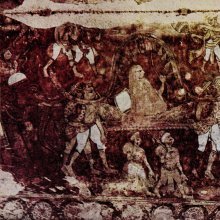Palanquin, Palankeen: 2 definitions
Introduction:
Palanquin means something in Hinduism, Sanskrit, the history of ancient India. If you want to know the exact meaning, history, etymology or English translation of this term then check out the descriptions on this page. Add your comment or reference to a book if you want to contribute to this summary article.
Images (photo gallery)
In Hinduism
Shaktism (Shakta philosophy)
Source: Brill: Śaivism and the Tantric Traditions (shaktism)Palanquin processions are involved in the worship of the Goddess, and formed a part of the Navarātra Tantric ritual (an autumnal festival of the warrior goddess Caṇḍikā).—Nine wooden shrines to be built on the Eighth lunar day (mahāṣṭamī), and the goddess is to be installed in a gold or silver image, in a sword or in a trident; worship involves chariot and palanquin processions.—Various 8th century sources refer to such rituals involving palanquins, for example: Devīpurāṇa, Kālikāpurāṇa, Kṛtyakalpataru, Durgābhaktitaraṅgiṇī, Durgāpūjātattva, Durgāpūjāviveka, Bhadrakālīmantravidhiprakaraṇa in Sanderson (2007); account of the Durgā Pūjā in Kelomal, West Bengal (Nicholas 2013).

Shakta (शाक्त, śākta) or Shaktism (śāktism) represents a tradition of Hinduism where the Goddess (Devi) is revered and worshipped. Shakta literature includes a range of scriptures, including various Agamas and Tantras, although its roots may be traced back to the Vedas.
India history and geography
Source: Singhi Jain Series: Ratnaprabha-suri’s Kuvalayamala-katha (history)Palankeens were commonly depicted on the Saṃsāracakra paintings (representing scenes of human life), in ancient India, as mentioned in the Kathās (narrative poems) such as Uddyotanasūri in his 8th-century Kuvalayamālā (a Prakrit Campū, similar to Kāvya poetry).—Page 185.21 f.: Here follows a description of a printed scroll illustrating the Jaina conception of saṃsāracakra. [...] The saṃsāra-cakra illustrated the three worlds of hell, human world and the world of gods. [For example:] A recluse sitting on a palankeen and invited by the king; a soldier fighting with weapons on the battle-field.

The history of India traces the identification of countries, villages, towns and other regions of India, as well as mythology, zoology, royal dynasties, rulers, tribes, local festivities and traditions and regional languages. Ancient India enjoyed religious freedom and encourages the path of Dharma, a concept common to Buddhism, Hinduism, and Jainism.
See also (Relevant definitions)
Full-text (+223): Shibika, Shivika, Naravahana, Shiraska, Yapyayana, Itya, Dola, Nrivahya, Rajayana, Palakhi, Paduwa, Hamala, Shiviratha, Shibiratha, Bhoi, Manushyayana, Vimanavaha, Myana, Andolika, Kaiyadde.
Relevant text
Search found 81 books and stories containing Palanquin, Palankeen; (plurals include: Palanquins, Palankeens). You can also click to the full overview containing English textual excerpts. Below are direct links for the most relevant articles:
Garga Samhita (English) (by Danavir Goswami)
Verse 6.17.23 < [Chapter 17 - Śrī Śrī Rādhā and Kṛṣṇa Meet at Siddhāśrama and the Nature of Śrī Rādhā’s Love Is Revealed]
Verse 6.17.19 < [Chapter 17 - Śrī Śrī Rādhā and Kṛṣṇa Meet at Siddhāśrama and the Nature of Śrī Rādhā’s Love Is Revealed]
Verses 3.6.3-5 < [Chapter 6 - The Test of Śrī Kṛṣṇa]
Ramayana of Valmiki (by Hari Prasad Shastri)
Chapter 25 - Bali’s Funeral Rites < [Book 4 - Kishkindha-kanda]
Chapter 117 - Rama sends far Sita < [Book 6 - Yuddha-kanda]
Chapter 76 - Prince Bharata commences the performance of the funeral rites < [Book 2 - Ayodhya-kanda]
Trishashti Shalaka Purusha Caritra (by Helen M. Johnson)
Part 5: Initiation of Mahāvīra < [Chapter II - Mahāvira’s birth and mendicancy]
Part 10: Sambhava’s initiation < [Chapter I - Sambhavajinacaritra]
Part 6: Vimala’s initiation < [Chapter III - Vimalanāthacaritra]
Chaitanya Bhagavata (by Bhumipati Dāsa)
Verse 1.13.40 < [Chapter 13 - Defeating Digvijayī]
Verse 1.14.8 < [Chapter 14 - The Lord’s Travel to East Bengal and the Disappearance of Lakṣmīpriyā]
Verse 1.15.137 < [Chapter 15 - Marriage with Śrī Viṣṇupriyā]
The Bhagavata Purana (by G. V. Tagare)
Chapter 10 - Bharata’s Life: King Rahūgaṇa accepts discipleship < [Book 5 - Fifth Skandha]
Chapter 12 - Dialogue between Bharata and Rahūgaṇa < [Book 5 - Fifth Skandha]
Chapter 75 - Discomfiture of Duryodhana < [Book 10 - Tenth Skandha]
The Agni Purana (by N. Gangadharan)
